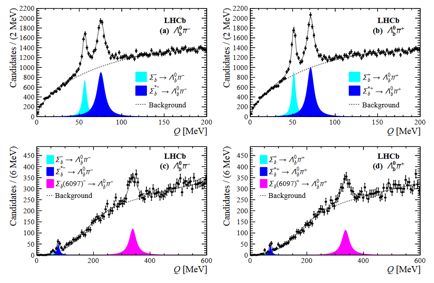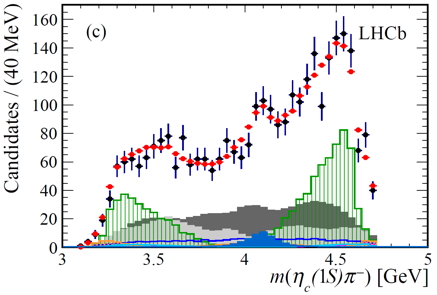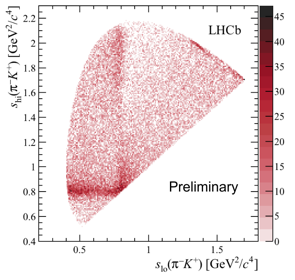The LHCb Collaboration presented new interesting results at the Large Hadron Collider Committee (LHCC) open session and at the CKM workshop in Heidelberg. Selected topics are listed below.
(1) Observation of two new particles in the Λb0π± system. LHCb physicists observed and studied two new Σb particles—as well as four known ones—in the invariant mass spectrum of the two-body system Λb0π±, consisting of a neutral Λb0 baryon and a charged π meson. These Σb particles manifest as peaks above the smooth background, as shown in the image; on the x-axis, Q=m(Λb0π±)-m(Λb0)-m(π±). The Λb0 baryons are reconstructed via their decay Λb0→ Λc+π–, with the Λc+ baryons in turn decaying to pK–π+.
In the quark model, the Λc+ and Λb0 are each composed of three quarks: udc for Λc+ and udb for Λb0. They are heavier partners of the well-known strange baryon Λ0, which is composed of uds quarks and whose discovery pre-dates the Standard Model. The Σb family of resonances have slightly different combinations of light quarks: uub for Σb+ and ddb for Σb–. In each of the upper plots, there are two peaks clearly visible (blue) that are identified as the Σb± and Σb*± baryons, which were observed previously by the CDF collaboration. LHCb confirms the CDF results, improving the precision on those particles’ properties by a factor of 5. Beyond these two particles, additional excited states are expected at higher masses. The lower images show mass spectra over a wider range and with stricter selection requirements. The peaks in the lower plots (pink) represent the first observation, with significances of 12.7σ and 12.6σ, of two new particles named the Σb(6097)+ and Σb(6097)–. They are likely to be part of same family of excited states of the Σb baryons. Theoretically, the family of excited Σb states whose mass is closer to that of the new observed particles is composed of five Σb(1P) states, some of which may be difficult to observe experimentally. Since it’s possible that the masses of different excited states may be similar, it cannot be excluded that the structures seen are superpositions of more than one state.
The search for and study of these states will cast light on the internal mechanisms governing the dynamics of the strong force that binds quarks inside hadrons. Read more in the LHCb presentation, in the LHCb paper, in the CERN update in English and French and in the CERN Courier article.
(2) Evidence for an exotic particle decaying into ηc(1S)π–. In the quark model, strongly bound particles (hadrons) are formed from combinations of quarks (q) and antiquarks (q) that have no overall colour charge. Until relatively recently, only two classes of hadron were known experimentally: qq pairs (mesons) and sets of three quarks qqq or qqq (baryons and antibaryons). These are referred to as conventional hadrons; those which do not fit into either of the categories are called exotic hadrons. The LHCb collaboration made important contributions through the study and discovery of exotic particles, like exotic mesons (which could be tetraquarks) composed of two quarks and two antiquarks qqqq, and pentaquarks, composed of four quarks and one antiquark qqqqq. An interesting feature of the exotic particles is that they contain a heavy charm quark-antiquark pair, cc, and therefore charmonium mesons like J/ψ or ψ(2S) (sometimes denoted ψ’) were observed in their decays. (For more on those, the Particle Data Group has a review of the charmonium system in pdf format.)
At the LHCC open session, the LHCb collaboration presented the first evidence for an exotic particle decaying into another charmonium (cc) meson, the ηc(1S), plus a π–. The ηc(1S) was reconstructed through its decay to a proton (p) and an antiproton (p). Instead of looking for any combination of an ηc(1S) and a pion, the researchers studied those from the decay of a B meson: B0→ ηc(1S)K+π–. In the absence of exotic resonances, this B0 decay would proceed predominantly through intermediate kaon resonances, such as K*0→K+π–, as shown in the left Feynman diagram. The right diagram shows a possible contribution proceeding through an exotic particle denoted the Zc–, with minimal quark content ccdu, which then decays into the two-body system ηc(1S)π–.
The images above show the invariant mass spectra of the ηc(1S)π– system (from the B0 decays discussed above). The left image shows the results of a best description of the data based on a model using only conventional hadron resonances (particles), like those included in the left Feynman diagram. A discrepancy is visible around 4.1 GeV. The right image shows what happens when contributions from an exotic resonance, the Zc–(4100), are allowed: a much better description of the data is obtained. The significance of this new exotic candidate is more than 3σ when including systematic uncertainties. This result was obtained with the LHC Run 1 data plus part of the Run 2 data (4.7fb-1 in all). LHCb will have recorded approximately twice this amount of integrated luminosity by the end of Run 2, so inclusion of the rest of the Run 2 data in a future update of the analysis will improve the precision and help clarify whether this intriguing hint is indeed a new, exotic particle. Read more in the LHCb presentation, in the LHCb paper and in the CERN Courier article.
(3) Measurements of the branching fractions of rare decays of charmed mesons. LHCb physicists presented measurements of the branching fractions of rare decays (for experts: doubly Cabibbo-suppressed) of charmed mesons Ds+ (with quark content cs)) and D+ (cd)). Precise measurements of these branching fractions provide important information for the understanding of the decay dynamics of these particles. Modeling these decay dynamics for charm mesons is a challenging theoretical problem: the charm quark mass is not heavy enough for robust application of theoretical methods that are used successfully in calculations of B meson decays, but not light enough for an exhaustive, brute-force approach either (which has more success for lighter K meson decays).
Measurements of the branching fractions of the rare charm meson decays D+→K–K+K+, D+→π–π+K+ and Ds+→π–K+K+ were reported. The distribution of Ds+→π–K+K+ candidates across the Dalitz plot is shown in the image, where the presence of intermediate particles (resonances) in the decays can be identified as highly populated regions or bands. Numerical values can be found in the LHCb presentation and in the LHCb paper, and are the most precise results obtained for these decays up to date.






